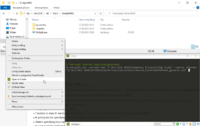Creating an animation rig in Blender: Difference between revisions
(Moved "Rotation order issue between Oni and Blender" and "Textures on animated models" subheaders to Blender while linking them) |
|||
| Line 42: | Line 42: | ||
===Tools and relevant tutorials=== | ===Tools and relevant tutorials=== | ||
[[Image:Cmder.png|200px|right|thumb|Screenshot showing Cmder's capabilities within the context of modding Oni]] | |||
* [http://mods.oni2.net/node/38 '''Current version of OniSplit.'''] This is the tool needed to import and export assets out of Oni. '''DO NOT USE OniSplit GUI or Vago for importing Oni assets into Blender''' - neither of these weren't updated in a long time, and thus they don't support OniSplit's v0.9.99.2 -blender option. You can still use them for other purposes though, such sounds and converting .oni files to XMLs, etc. | |||
* [https://cmder.net/ '''Cmder'''] (Windows only) - because OniSplit is a command line tool, it is highly recommended to get any upgrade to Windows' Command Prompt. As shown in the screenshot on the right, Cmder allows you to start it from the context menu in any selected folder, and it also remembers your most recently used commands, vastly improving your workflow when you're forced to use any command line tools. | |||
* [https://docs.google.com/document/d/175uJGklYASAgrFjxuUG4-kJRDoMTjjP7GvNxSj1GscU/edit '''Oni-Blender tutorial'''] by EdT. Please read this in entirety to know likely-to-happen issues and refer to this as your guide for OniSplit commands relating to Blender. | |||
* [http://oni.bungie.org/forum/viewtopic.php?pid=23230#p23230 '''Brief overview on creating TRAMs'''] by EdT - while this was written with XSI in mind, this is still relevant as the process for preparing the XML files for Oni is still the same. Also the next post in that thread, called '''Brief walk through on modifying a TRAM,''' is an example of that overview put into practice. | |||
===Rotation order issue between Oni and Blender=== | |||
[[Blender#Rotation_order_issue_between_Oni_and_Blender|Please refer to THIS.]] | |||
===Textures on animated models=== | ===Textures on animated models=== | ||
[[Blender#Broken_alpha_transparency_and_textures_on_animated_models|Please refer to THIS.]] | |||
[[Category:Modding tutorials]] | [[Category:Modding tutorials]] | ||
Revision as of 15:30, 7 September 2021
Introduction
This tutorial shows you how to create the animation rig for Blender (made by geyser), with some improvements.
The purpose of this rig is to give us much better tools to animate, compared to our previous process in Softimage XSI by EdT, which allowed us to animate exclusively with Forward Kinematics. While FK may work for simple, short animations done on characters with a small amount of bones, it does not work well for Oni characters and animations, as it's too labor-intensive and inefficient.
Prerequisite tutorials
I highly recommend watching the tutorials below if you feel you're lacking knowledge in any of these subjects:
General Blender basics:
Blender Character Rigging overview showing that you can create a Rigify rig in less than a minute at 5:43, and also rig a character while at it:
Basics of using Rigify:
Rigify Bone Groups and Layers:
- Rigify Tutorial 7-1: Rigify Bone Groups and Layers (Overview) by CGDive
- Rigify Tutorial 7-2: Rigify Bone Groups and Layers (Practice) by CGDive
- Rigify Tutorial 7-3: Rigify Bone Groups and Layers (Advanced) by CGDive
Changing Rigify Custom Shapes and Widgets:
- Rigify - Custom Shapes/Widgets by CGDive
Blender custom properties and drivers (drivers are used to set the influence of a rig's bone constraints through the Pose1 and Pose2 bone locations):
- Custom properties and drivers in blender made easy by Pierrick Picaut
Tracking constraint tutorials
These explain constraints like Damped Track which are used by Rigify – you can skip this if you want, but it might explain a thing or two, or come in handy in the distant future; other than that, you don't need to know them to animate for Oni:
- Tracking Constraints - Blender 2.80 Fundamentals
- Camera Track To vs Damped Track Constraints | Pros & Cons Explained With Examples | Blender by 5 minutes Blender
Things to know before starting
There are several things worth knowing before you start creating the rig.
Tools and relevant tutorials
- Current version of OniSplit. This is the tool needed to import and export assets out of Oni. DO NOT USE OniSplit GUI or Vago for importing Oni assets into Blender - neither of these weren't updated in a long time, and thus they don't support OniSplit's v0.9.99.2 -blender option. You can still use them for other purposes though, such sounds and converting .oni files to XMLs, etc.
- Cmder (Windows only) - because OniSplit is a command line tool, it is highly recommended to get any upgrade to Windows' Command Prompt. As shown in the screenshot on the right, Cmder allows you to start it from the context menu in any selected folder, and it also remembers your most recently used commands, vastly improving your workflow when you're forced to use any command line tools.
- Oni-Blender tutorial by EdT. Please read this in entirety to know likely-to-happen issues and refer to this as your guide for OniSplit commands relating to Blender.
- Brief overview on creating TRAMs by EdT - while this was written with XSI in mind, this is still relevant as the process for preparing the XML files for Oni is still the same. Also the next post in that thread, called Brief walk through on modifying a TRAM, is an example of that overview put into practice.
